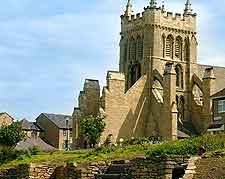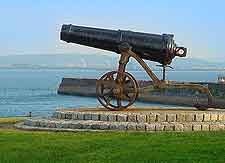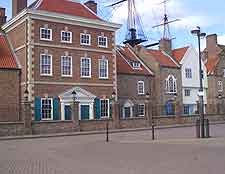Hartlepool History Facts and Timeline
(Hartlepool, County Durham, England, UK)

The original town of Old Hartlepool, known locally as the 'Headland', was founded on the site of a monastery that dates back to Anglo-Saxon times. The monastery was destroyed during a Danish raid in 800 AD.
The name Hartlepool is thought to derive from 'heopru', the Saxon term for the place where harts, or deer, drink.
Medieval Hartlepool
In the 12th century, St. Hilda's Church was built on the site as a burial place for the powerful local Norman family of De Brus. As a natural harbour, Old Hartlepool soon grew into a small fishing town. King John granted it a Royal Charter in 1201.
By the 13th century the town had become strategically important for the powerful Bishops of Durham and the Crown. The ever-present fear of Scottish attack led to the building of defensive walls around the town, which marked an important period of local history and fortification. During early modern times, Hartlepool developed into one of the busiest ports on England's east coast.

A Place for Shipbuilding
When the early 19th century arrived, Hartlepool had become more of a resort than a fishing port. It was a place where the 'better off' came to enjoy the fresh sea air.
In the 1830s, though, this all changed. National demand for coal after the Napoleonic Wars made it economically feasible for coal to be transported from Hartlepool in the north of
England to
London in the south. A railway was built to link the collieries of the South Durham coalfield with Hartlepool and work began on modern docks soon after. In 1844, another dock was built, to the south-west of the old town.

A rival West Hartlepool Dock Company was set up, which opened in 1847. A new town grew up around it. Known as West Hartlepool, it grew at a rapid pace, soon overshadowing the old town to the east. By the dawn of the 20th century, the two towns that made up Hartlepool had once again become one of the busiest ports in Britain.
The outbreak of World War I in 1914 fuelled Hartlepool's success as a centre of the shipbuilding industry. Indeed, the town was thought to be so strategically prominent that it was the target of several German attacks.
The move away from heavy manufacturing in Britain with the closure of the shipbuilding docks from the 1960s brought change once again to Hartlepool, with the subsequent transformation of the old docks into a new marina complex.
 The original town of Old Hartlepool, known locally as the 'Headland', was founded on the site of a monastery that dates back to Anglo-Saxon times. The monastery was destroyed during a Danish raid in 800 AD.
The original town of Old Hartlepool, known locally as the 'Headland', was founded on the site of a monastery that dates back to Anglo-Saxon times. The monastery was destroyed during a Danish raid in 800 AD.
 A rival West Hartlepool Dock Company was set up, which opened in 1847. A new town grew up around it. Known as West Hartlepool, it grew at a rapid pace, soon overshadowing the old town to the east. By the dawn of the 20th century, the two towns that made up Hartlepool had once again become one of the busiest ports in Britain.
A rival West Hartlepool Dock Company was set up, which opened in 1847. A new town grew up around it. Known as West Hartlepool, it grew at a rapid pace, soon overshadowing the old town to the east. By the dawn of the 20th century, the two towns that made up Hartlepool had once again become one of the busiest ports in Britain.